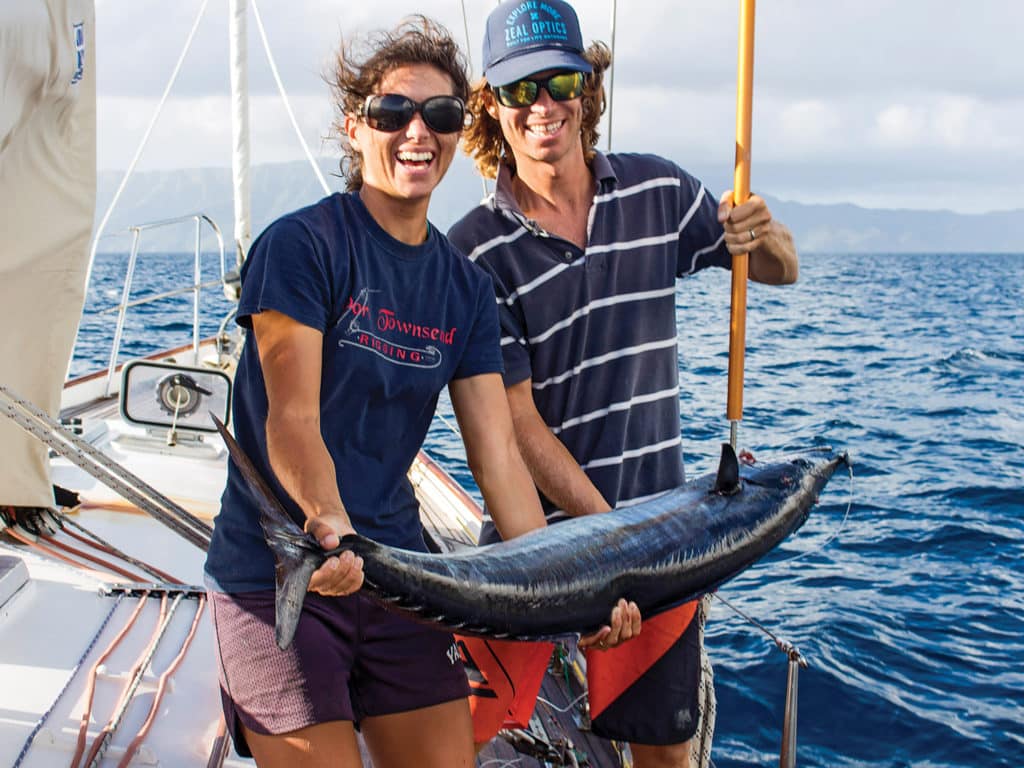
It’s taken me a surprisingly long time, given how much of my life I’ve spent around oceans, but I’m finally into fishing.
Fishing (and catching), I discovered as many others have before me, is the perfect complement to life aboard a sailboat. It’s fun—once you acclimate to the killing part. There’s nothing quite so delicious as truly fresh fish, and you have the great satisfaction of providing for yourself on the most basic level.
I caught my first fish 10 years ago when my husband, Seth, and I were cruising in Fiji during our circumnavigation aboard our Spartan 1968 cutter Heretic. That first fish was a 25-pound mahimahi, and it provided us with delectable ceviche once I’d gotten over the trauma of killing it. I was 22 years old and had never killed anything bigger than an insect, so knifing this beautiful fish was a lot tougher than I’d anticipated, both physically and emotionally. It took me about six hours before I was ready to eat the fish, but by then I’d decided that if I couldn’t kill something, I shouldn’t eat it, and if I had killed it, I couldn’t let it go to waste. Plus, I love mahimahi. So, we prepared it the Tahitian way—marinated in lime juice and served in coconut cream.
Seth and I continued to fish throughout our circumnavigation, catching wahoo, tuna, Spanish mackerel and more mahimahi. The strike was always exciting, and fighting them in on the hand line always a thrill. I got decent at gaffing these big fish, and we cottoned on to the trick of using alcohol in their gills to stun them before dispatching them to their fish heaven. But the actual fishing part was fairly passive; once we’d rigged up a few lures, we paid out the hand line in our wake and kept on sailing. If we weren’t catching anything, Seth would reel in the lines and tie on other lures to try something else. He enjoyed playing with different combinations, even concocting his own lures out of random bits and pieces. I couldn’t get into it though: If there was nothing biting, I preferred reading or watching the birds.
Until our last summer in Alaska.
We first sailed to Alaska five years ago aboard our current boat, a classic cold-molded wood cutter named Celeste. Having fished only for pelagic tropical species, we rigged up our hand lines as if we were on passage to Tonga. Anyone who’s fished for salmon will laugh as they read this. Unlike warm-blooded tuna, salmon swim slowly, and at depth. To troll for salmon, you need a downrigger to pull the line to 40 or so feet below the surface, and you need to drop your speed to about 2 knots. You also need to pick a good location—the salmon aren’t just anywhere. All of a sudden, you’re no longer fishing while sailing; you’re sailing in order to fish.
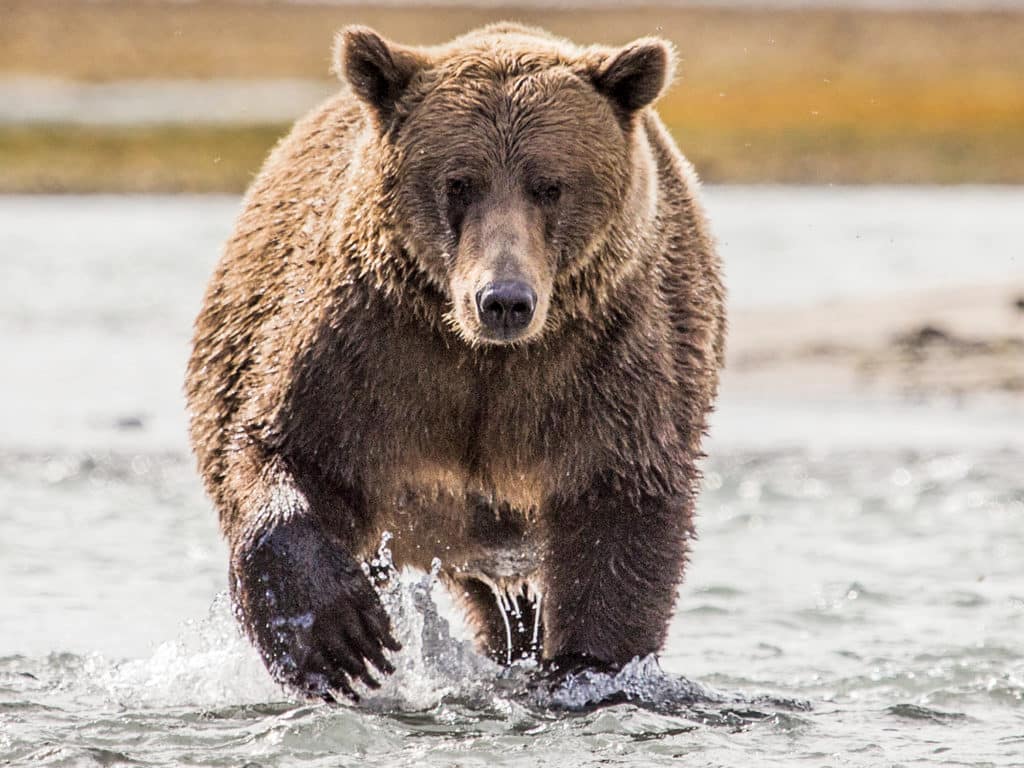
We couldn’t get the hang of this for two reasons. First, we hate going slow, and we were trying to cover large distances before we had to return to work ashore in the fall. We were trying to sail from Port Angeles, Washington, to Dutch Harbor in the Aleutian Islands—farther west than Hawaii—and hoping to see the Inside Passage, Prince William Sound and Katmai National Park along the way. The weather in Alaska, even in summer, isn’t consistent, so on any day with good wind, we wanted to make the most of it. And second, we really had no idea what constituted a good location for catching salmon, so we caught nothing and got more and more discouraged. Other sailors and local fishermen—both recreational and commercial—took pity on us, and, with our pride banished, we thoroughly appreciated their gifts of salmon, halibut and rockfish.
The following year, we didn’t even really try to fish. We had set ourselves perhaps our toughest goal yet—to sail to the Arctic Ocean and back to Dutch Harbor in the two months we had free from work. The distance, conditions and lack of sheltered anchorages were all challenging enough to keep us fully occupied.
RELATED: Sailing Alaska: Close Encounter with Orca Whales
Our third summer in the north was another rushed season, retracing our wake from Dutch Harbor back to Washington state, where we planned to do some big repairs to Celeste, so again we didn’t fish. It wasn’t until our final year in Alaska that we set off north with the expressed goal of catching lots of salmon. It was time to redeem ourselves.
Our first step was to contact a friend of ours in Anacortes, Washington, who is an avid sailor and fisherman. Jim has made 17 trips up and down the Inside Passage from Puget Sound to Juneau, and always has great success as an angler. He helped us enormously with several pages of tips on how to locate likely spots, and also the best gear for trolling for salmon, casting for salmon, and bottomfishing. We had a good casting setup, but we’d been loath to spend the money on a good trolling rod and reel. In the end, we went for it, justifying it by saying that it was burly enough to use as an additional line in the tropics too.
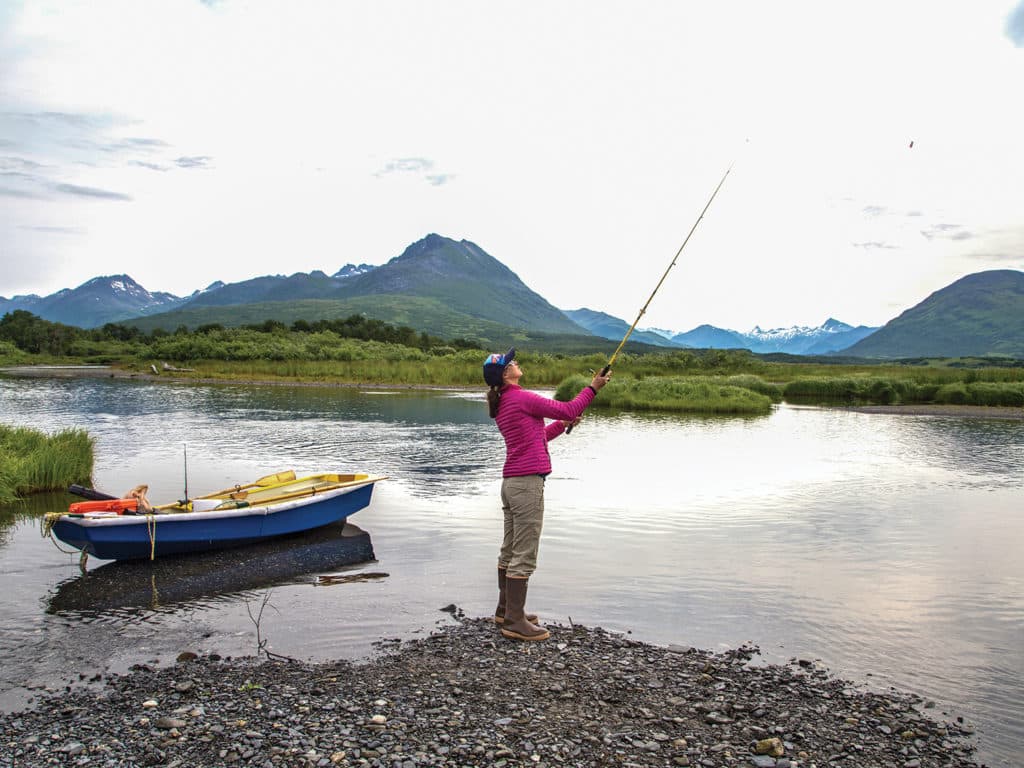
Thus armed, we set out to put in quality time inching along at 2 knots close to steep, rocky shores, preferably on an ebb tide, as per instructions. Still, we caught nothing. But then we reached Petersburg, Alaska, before Memorial Day and learned that the holiday weekend was to be the King Salmon Derby. We didn’t enter, of course, but we figured there had to be fish out there if they were having a tournament. So we tried again, this time from our dinghy, which is a 10-foot rowboat. And I got my first bite! The fish got off before I could reel it in all the way, but after that, we couldn’t not try.
We crossed the Gulf of Alaska for the Kenai Fjords in early June and quickly found a likely estuary in which to cast. We actually saw several salmon swimming where the river meets the ocean. This time I hooked one and had a long fight, letting him run out with my light casting line (not wanting it to break), and then reeling in fast when I got a chance, until, right in the shallows, he got off. I was very disappointed, but we’d both had a wonderful day casting, all alone on the banks of this beautiful river, surrounded by silent evergreens and colossal mountains, with a view of a tidewater glacier. It doesn’t get much better. Though we did vow that next time we’d wear more bug spray.
Seth and I both had so much fun that we bought another casting rod when we reached Kodiak so we no longer had to take turns. Meanwhile, though, we’d had our first success with our trolling rig. We’d set it up on a daysail in the Kenai Fjords, thinking the zephyr-like breeze would give us perfect speed for salmon fishing. Then the wind died to nothing. Not wanting to disturb the serene quiet, and also because we were running low on fuel in the middle of the wilderness, we didn’t start our engine. The trolling line sank to the seafloor, some 250 feet down, and when we brought it up, there was a fish! Not a salmon, but a black cod. Also called sablefish, black cod are valuable bottomfish that fetch high prices on the Asian market and rank among what some of our Alaskan friends term “Gucci fish”—expensive fish for fancy people. We filleted and grilled it, and its creamy white meat was just as scrumptious as you’d expect.
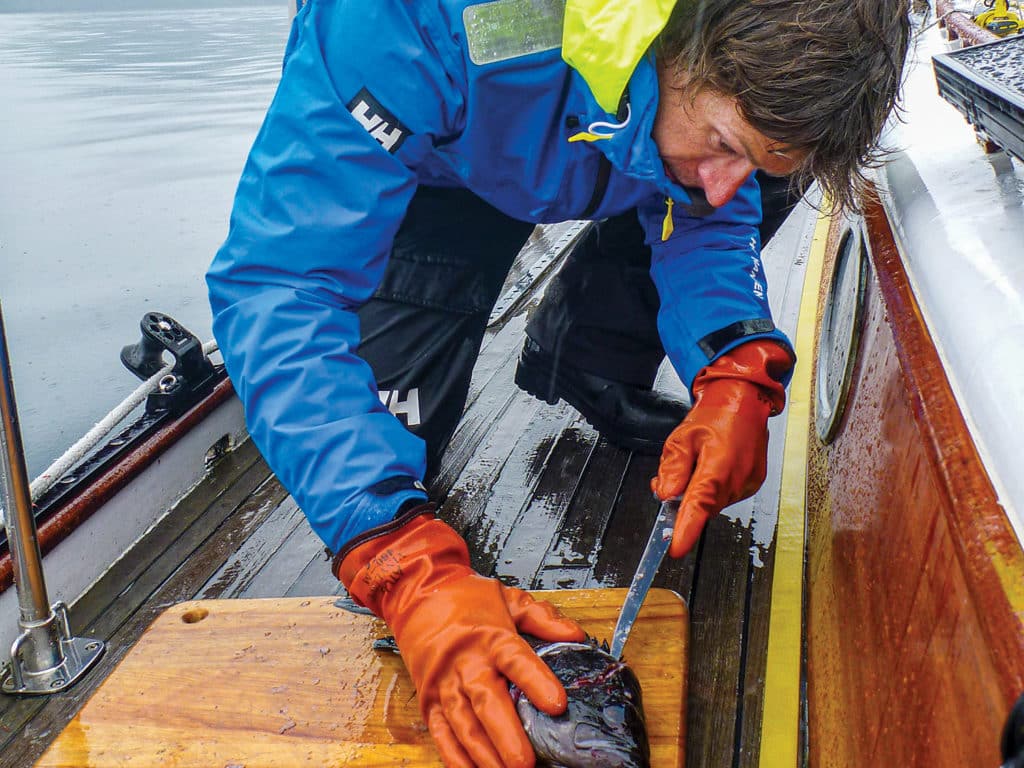
We caught two more bottom feeders this way—two rockfish off the coast of Kodiak. They were some of the most difficult fish we’d ever filleted—between their venomous spines and slippery, scaly bodies—but they were a real treat on the plate, once again just grilled with a little butter.
Then we got down to the real business of catching salmon. We found an estuary where it appeared that a lot of salmon were running; commercial set nets dotted the bay. From the fishermen who operated these nets, we learned that we had found a run of pinks and sockeyes (or “reds,” so called for their deep red flesh). Sockeyes are one of the most sought-after salmon, but we didn’t catch any of those this time. As we cast again and again into the brackish water, only the pinks would bite our lures. Our fishermen friends confirmed this: The sockeye won’t bite at all once they come in from their offshore feeding grounds. To get sockeye, you have to snag them and, as easy that sounds, there’s a definite knack to it—and neither Seth nor I seemed to have it.
It’s a measure of our success with the pinks, however—and with our accelerating excitement over our success—that one day, when we were higher up the river than usual, we didn’t even notice as a young brown bear entered our territory. No doubt he thought it was his territory. He started lunging at the water with his front paws, not in a charge, but in something that looked like it could become one if we lingered. It surely didn’t help that we had a bucketful of bloody fish at our feet.
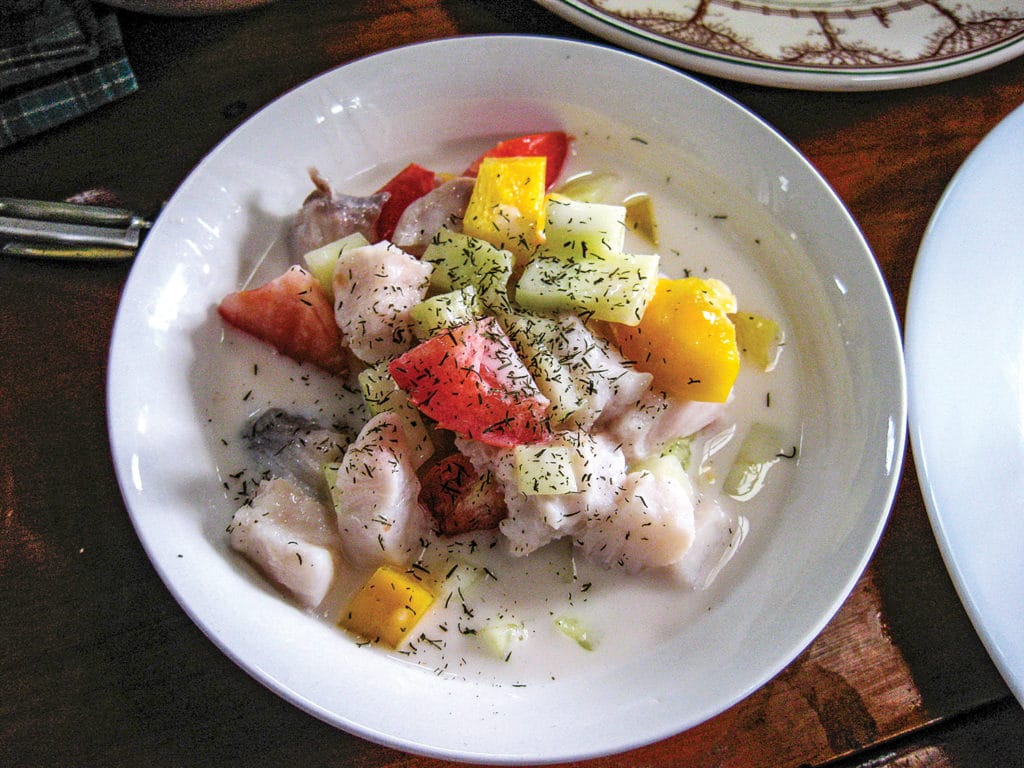
Both of us wanted to cede the creek to him, but we were trapped. We couldn’t get in our dinghy and row upstream and away from him because the water had become much too shallow. Nor could we row downstream because then we’d go right toward him, and the creek wasn’t broad where he was making his menacing stand. And, of course, this was the one day we’d forgotten both our bear spray and our 12-gauge shotgun, the latter of which would certainly have scared him off.
So, like dimwits, we just stood there, frozen. The bear climbed back up his bank and started through the grass, upstream, toward us. We scrambled to get our gear back in the dinghy in preparation to make as much of a dash for it as our oars could manage, once he was abreast of us and no longer downstream. But he just strolled right past. I was still all for getting out of there, but, now that the immediate danger was past, Seth was keen to keep casting. He got in one or two more before the bear appeared in the grass of the opposite bank. We quickly beat our retreat, happily still with our bucketful of fish.
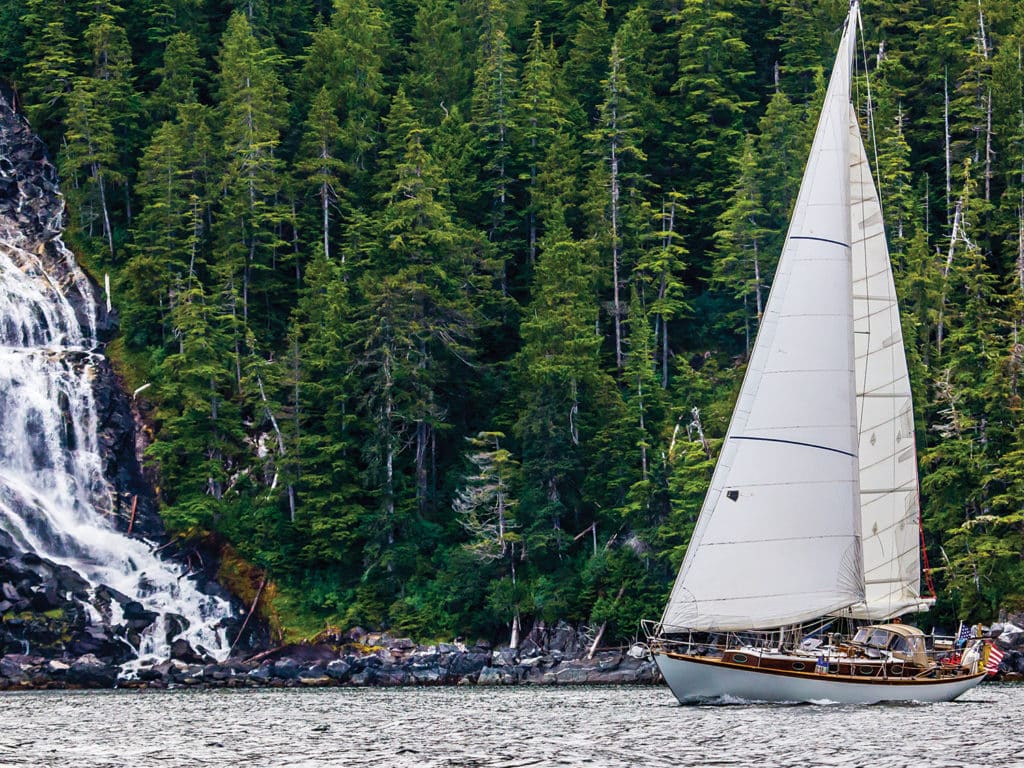
Over the days we were anchored off this creek, we’d caught about a dozen salmon and felt that we’d finally redeemed ourselves. Not only had we finally caught fish, we’d caught so many that we couldn’t eat them all. Time for a little smoking. We turned our little Sea-B-Q into a smoker by adding green alder branches to it and turning the flame down low. That was step one. Step two was to can the meat in Mason jars in our big pressure canner. The canner does 16 half-pint jars (or eight pint jars) at a time and fits fairly easily on Celeste’s Force 10 galley range burners. Pressure canning is both safer and more forgiving than water-bath canning, and is the only safe way to can fish. Following a long afternoon and evening, we had 24 jars of smoky-flavored salmon preserved. Not only had we provided ourselves with dinner, we’d even provisioned our boat ourselves!
Now we were really and truly into it. As all anglers know, casting in a quiet river is one of the most calming, meditative, peaceful joys of life. This is (hopefully) punctuated by the thrill of a strike and the excitement, but at the same time, the controlled finesse of fighting and landing the fish. Then comes the satisfaction of cooking and eating something you didn’t buy.
So, although we were now sailing around with two dozen pint jars of salmon, we couldn’t help fishing yet again when we were back in the Kenai Fjords at the height of the sockeye run. I got another big pink for dinner on our first night anchored off the rivermouth, but the next day, things kicked into high gear.
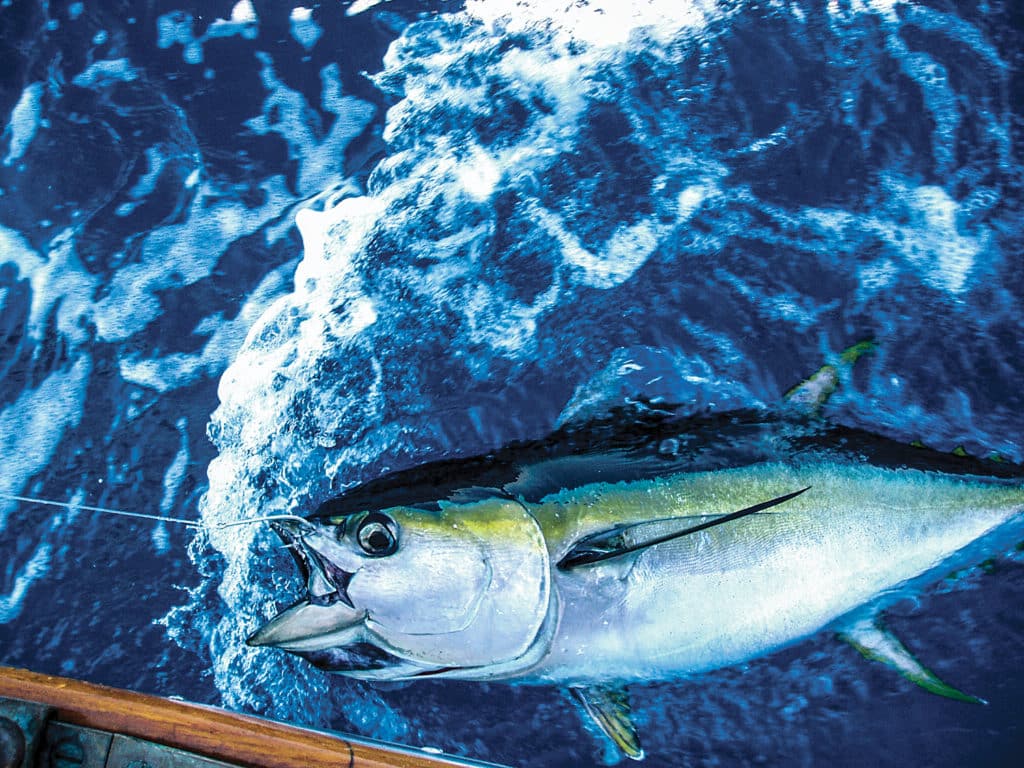
Two Piper Cub planes appeared in the west, circled the fjord, and made superb bush landings on the beach. The pilots emerged with waders, rods and nets—two old friends out for a day’s fishing. Both men were in their 80s and had lived in Alaska for years. And could they fish! One cast and they’d have a sockeye, and another and another. And remember, the sockeye don’t bite lures. These guys were snagging the reds (snagging is legal in salt water), and we could tell that there was a definite technique to it. As we got to talking, they started to teach us: how to discern a school coming close; just how to cast into them and let the big snag hook sink a little; and then how to jerk fast and hard to catch the hook in one of the fish. Depending where you snag a salmon, you can be in for a long, hard fight. Snagging in the tail is the best, or worst, depending on how tired you are.
Snagging needs heavier line than I had on my reel, so I lost two or three hooks before I landed my first sockeye. Seth was better at it, and landed four salmon—a pink and three reds—before I finally got my sockeye toward early evening. I was all excited and ready to cast again when the resident black bear appeared. We’d seen him in the morning—in fact, we’d had to abandon our fancy Canon DSLR camera to his investigations (which fortunately ended safely for all involved)—and now here he was again, probably just curious. But after fishing all day for that one sockeye, there was no way I was going to be parted from my hard-earned catch. The dinghy was between me and the bear, so when I grabbed the bucket and ran for the dinghy (and in the direction of the bear), I so surprised him that he booked it into the trees. Seth and I launched the dinghy and rowed for home. The bear had to eat too, after all.
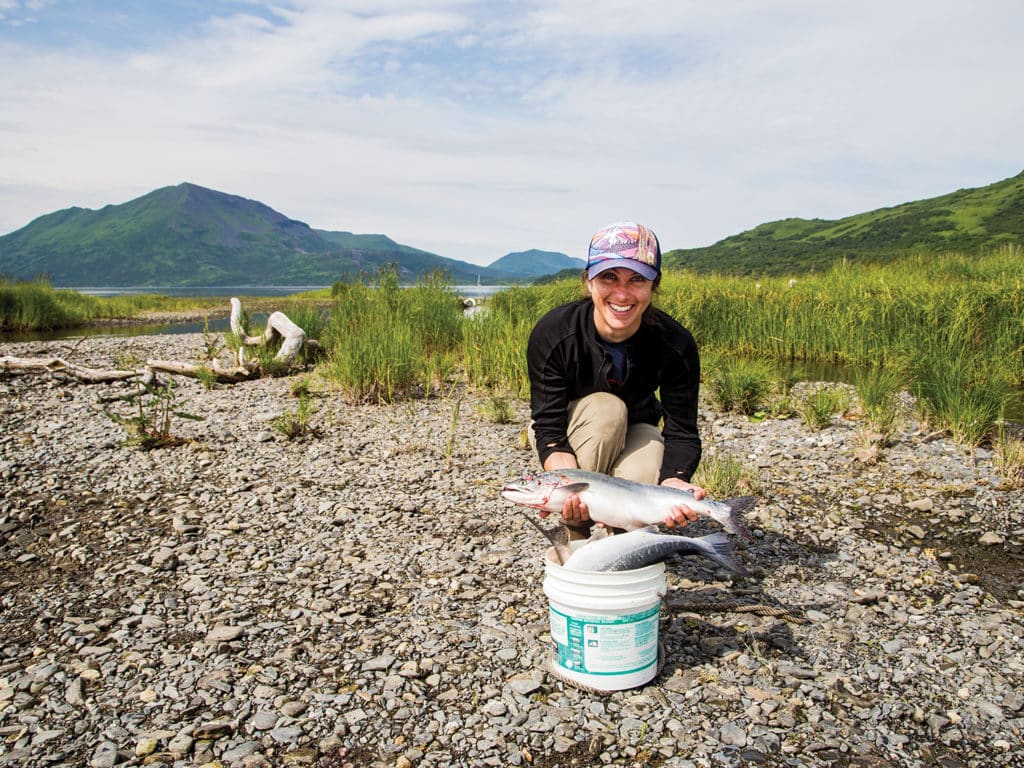
Back in the Inside Passage and heading south at the beginning of September, we trolled for silver, or coho, salmon, the last to come in for spawning. We must have picked a good spot because we got three bites and landed two, all within 20 minutes. They were our biggest fish yet and the first salmon we’d caught by trolling. Now we felt fully redeemed: We’d caught every type of salmon except king, and we’d joined the ranks of Alaskans who stock their larders each year with their own catch. When we said goodbye to Alaska, a shower of green Aurora Borealis lighting up the sky in our wake, we had over 50 jars of salmon to eat on the passages ahead of us.
Now that we’re back in the tropics, with the old hand lines trailing for tuna and wahoo, I haven’t lost my newfound passion for fishing. I miss the casting and the snagging, but the thrill of hooking a huge, pelagic gamefish is really one of the most exciting things afloat. And it’s great to finally have the roles reversed from our first Alaskan summer. No longer the sad, fishless cruisers hoping for a handout, Seth and I were happily giving away our excess catch as we sailed through Polynesia. And, of course, serving as hors d’oeuvres (read: showing off) our home-canned, home-smoked, self-caught Alaskan salmon.
Ellen Massey Leonard has been sailing offshore since age 20, when she and her husband, Seth, set off to voyage around the world. Following their circumnavigation, they sailed extensively in Alaska and the Arctic before returning to the South Pacific via Mexico, celebrating 50,000 miles on the crossing.
Alaskan Fishing Regulations
Alaska’s fish stocks are still holding up well in a world of overfishing thanks to strict regulations, enforcement by the Alaska Department of Fish and Game, and a culture of self-control. Booklets with the current sport-fishing regulations for each region (Southeast, South Central, etc.) are freely available in all fishing stores, harbor offices and tourism bureaus. They include information on seasons, bag limits and size limits for all species of interest, including shellfish; allowable gear; and special regulations for specific waters, fresh and salt. They also have useful pictures to help identify your catch, instructions for deepwater release of rockfish, and tips for fishing in bear country and for killing and cleaning your catch most effectively. All fishermen must obtain a license; nonresidents may choose between licenses good for one day, three days, one week, two weeks or a year. The annual nonresident license costs $145. If you plan to fish for king salmon, you’ll need an additional king salmon stamp.
Fishing Gear
All anglers have their own gear and tricks, of course, but this is what we have aboard Celeste:
- Two light casting rods (one for each of us) with 12-pound-test line on the reels.
- An assortment of spinners and spoons with small treble hooks for casting for salmon and Dolly Varden trout, and a bunch of weighted treble hooks for snagging salmon. (Heavier line would be better for snagging.)
- A 7-foot heavy rod with 80-pound-test line on the reel for trolling for salmon and bottomfishing. (You can use as light as 50-pound, but we wanted it to use it in the tropics too.)
- A planer, a big flasher, and an assortment of “twinkle skirts” for trolling for salmon.
- A variety of leaders, swivels, snaps, weights and the like for rigging different setups, depending on what we’re targeting.
- A hand-line reel with 300-pound-test line for tropical fishing, and bungees to prevent shock loading when a fish strikes.
- Bigger spoons for wahoo, and lots of different plastic squids and jet heads for mahimahi and tuna.
- Gloves for hand-lining and for handling Alaskan rockfish.
- A net for landing salmon and a gaff for tropical fish.
- A small club (or a rock) for killing salmon, and a bigger club, cheap liquor, and an incredibly sharp knife for stunning and then killing tropical fish.
- A big cutting board and long, sharp filleting knife for cleaning and preparing.








